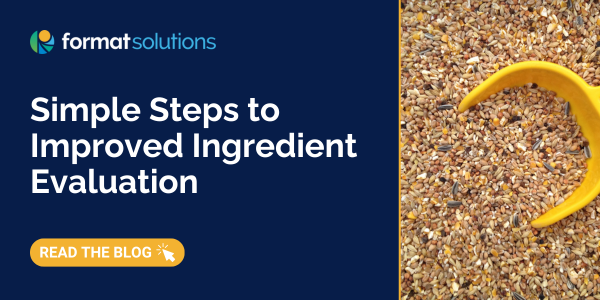Simple Steps to Ingredient Evaluation

Effective ingredient evaluation means determining which ingredients are the most suitable for the recipes you manufacture and their various components by comparing their economic, nutritional, and other quality benefits.
Ultimately, you want to find the most cost-effective way of delivering the right quality and nutrition to your customers and their animals, says Ian Mealey, Format Solutions’ Product Marketing Director – Formulation.
When developing a recipe, it’s crucial you select the optimal mix of ingredients. This is vital for ensuring high quality across all the products you manufacture. Fortunately, formulation software has made it far easier to evaluate your ingredient selection and take fundamental decisions about which ingredients you need to purchase, how many, when, and at what cost.
It’s not always a simple question of economics. An ingredient that appears attractive pricewise, but has variable quality or unreliable supply, may not be the best choice. You may be selecting the right ingredients, but you need to purchase the right quantity at the right price. If you don’t have enough of them at the right moment or have overbought at the wrong time and are left with an excess, you will miss opportunities and it’s going to hurt your bottom line!
To further complicate matters, every factor is variable when it comes to ingredient evaluation – and you can't assume the decisions you made last year will be appropriate for the next:
-
Cost. We all know that the price of ingredients fluctuates for a variety of reasons: commodity markets, availability, seasonality, how successful a harvest has been and even, as has been seen recently, geopolitical tensions, along with countless other factors.
-
Availability. As well as affecting price, availability directly impacts our ingredient choices. For example, not being able to source the amount of a particular ingredient means we will have to find a cost-effective replacement.
-
Quality. Feed ingredients are naturally variable in quality. The protein of wheat, for example, can differ from one year to the next, or from one source to another. This variability could significantly affect an ingredient’s relative value in a diet. The level of an ingredient used in a previous mix may not always be appropriate now.
-
Demand. Recipes change over time, but so does demand for those recipes and therefore the ingredients that are required. Ingredient choices must be aware of changing demand so they are appropriate, otherwise decisions could have a marked impact on your costs.
Thousands of customers trust Format Solutions’ software to articulate scenarios just like these on a daily basis. We provide the essential tools that can manage the relevant information, calculate the various permutations, and model scenarios for the short, medium, and long term – quickly and accurately.
Selecting the most appropriate ingredients can be a complex and time-consuming task – but it’s made so much simpler by using formulation software.
To improve your ingredient evaluation process, it’s important to:
1) Carefully gather your data such as ingredient costs, their availability, any information on their quality, as well as sales or production forecasts, says Mealey.
2) Set a baseline - understand what your recipes, ingredient usage, and costs will look like if you do nothing.
3) Utilize optimization tools to see the potential impacts, carrying out deeper investigation using more sophisticated tools.
4) Communicate with all interested parties - quality, purchasing, technical, production and sales departments - to ensure good data inputs and enable better decision-making.
Available across all Format Solutions’ products, our Time Periods feature provides a useful closed environment where you can model the effect of different decisions. These act as a “virtual sandbox” to allow users to investigate specific scenarios. Recipes, ingredient usage and costs can be viewed for a specific plant or location, varying any of the inputs without affecting live recipes or affecting day-to-day work.
The best approach is to look at a scenario holistically using our Multi-Mix or Multi-Blend tools, which help to decide on the best and most appropriate recipe based on selected criteria. Our Single-Mix and Single-Blend tools are another great alternative, although they focus on only one product at a time.
Understanding price trends and the potential impact on your recipes is also vital to your decision making. For example, you may have finished your optimization exercises and are now ready to determine the amount of Soya you’ll need for the summer based on a cost of $400/tonne – but what if the price fluctuates? With our powerful Parametrics tool, it’s possible to quickly determine the effect of price changes on your recipes, so you can plan accordingly.
In this scenario, setting the price range from $300-500/tonne and adjusting the price in $25 increments, for example, can help build a clearer picture and enable you to buy advantageously in the light of this extra knowledge.
Ingredient evaluation requires strategic planning to make the right decisions, every time. The aim is to deliver the right quality products in the most cost-effective way, thus avoiding uncompetitive pricing or reduced margins. Companies that pay close attention to their ingredient evaluation tend to be the more profitable, with lower cost operations, says Mealey.
When it comes to effective ingredient evaluation, it's important to have an investigative mindset and ask the right questions. This can be a complex and time-consuming process, and the wrong decisions may prove costly. However, some simple steps can help: gathering good data into specific location and time-based scenarios, understanding your baseline and using powerful optimization tools to investigate possible future decisions and, importantly, what they might save.
Making those decisions becomes far easier and more precise with Format Solutions’ software.
To learn more about how our formulation software can help you boost your bottom line, get in touch.

